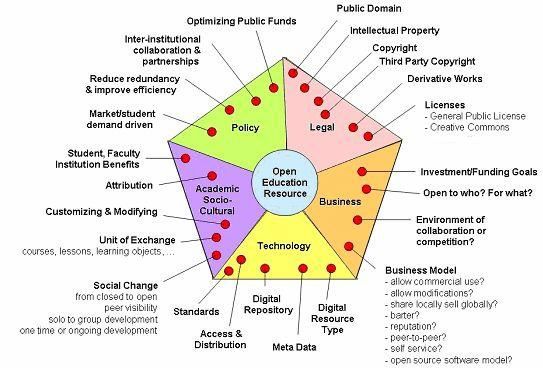Richard Wyles
My perspectives on OERs have been shaped by learding a NZ based OER project in 2006/07. There is a perception that innovation, and pluralism of ideas cannot co-exist with cost efficiency. OERs combined with a modular approach to courseware development is a way to achieve this co-existence. Modular build methodologies enable end-users (institutions and tutors) to modify, add to or reconfigure materials to fit in with their needs. Of paramount importance, modularity also ensures that courseware can easily be updated to reflect changing curriculum requirements. Modular designs help to streamline the development process by allowing developers to re-use existing elements.
Key Arguments for NZ Adopting Sustainable OER Framework
Educational institutions should leverage taxpayers’ money by allowing free sharing and reuse of resources developed by publicly funded institutions. To lock learning resources behind passwords means that people in other publicly funded institutions sometimes duplicate work and reinvent things instead of standing on the shoulders of their peers. It might be seen as a drawback for this argument that it does not distinguish between taxpayers in different countries – learning resources created in one country may be used in another country, sparing taxpayers in the second country some money. But free-riding of this kind may not pose so much of a problem since the use of a learning resource in a foreign country does not hinder the use of the same resource by domestic teachers. Similarly to the open source paradigm, so called “free-riders” tend to become customers of the originating body.
In a country like NZ with limited economic resources, we have more to gain by being an active member in a global community of open educational resource sharing and development. There’s a phrase used in open source - “What you give, you receive back improved.” Sharing and reusing can cut the costs for content development, thereby making better use of available resources. The overall quality should improve over time, compared to a situation where everyone always has to start from the beginning. Open sharing will speed up the development of new learning resources, stimulate internal improvement, innovation and reuse. When presented with a list of proposed goals or benefits with using OER in their own teaching, the most commonly reported motive was to gain access to the best possible resources and to have more flexible materials.
Options for courseware development
The areas of debate are around how make courseware development more cost-effective. There's a spectrum with some of these options at the polar ends:
Full Autonomy – No Framework, Decentralised While good practice will exist in pockets, so too will poor practice which will affect the credibility of OERs overall. In the e-learning field, a fully decentralised, autonomous, competitive model with duplicated outputs is not scalable as it would be prohibitively expensive to build e-learning courseware design capability and capacity throughout the sector. While autonomy provides a foundation for independent, innovative delivery, this is a moot point if it is unaffordable to achieve.
Centralised Courseware Factory The primary problem with a fully centralised initiative is that it soon turns into a recipe for mediocrity and lack of buy-in. It can be attractive due to the prima facie case for cost control, however the lack of pluralism inherent in a fully centralised model will undermine the necessary vibrancy in a successful education sector.
Collaborative OER Development Model This is my preferred vision for the way forward for NZ OERs. Under this model, an annual financial resource is made available either from ITP participants’ contributions or centrally provided by TEC. The funding would be contestable. The model or framework has the following characteristics.
1. Funds are granted on an application basis on a project by project basis, awarded by a Steering Group?Awards Committee, with possible direct representation from TEC. This could start out as relatively modest and build with successes. Public/private initiatives should be welcomed as there is a lot of good practice courseware development for private sector clients.
2. Good practice standards inform all development projects. Please note that adherence to standards is not to prescribe design, but to ensure interoperability, exchange and accessibility.
3. A modular design should be employed wherever possible to facilitate the re-use, re-purposing and disaggregation of the courseware. Modular build methodologies allow end-users (institutions and tutors) to modify materials to fit in with local needs. Crucially, it also ensures that courseware can easily be updated to reflect changing curriculum requirements. Modular designs also help to streamline the development process by allowing developers to re-use existing elements thereby reducing the overall cost.
4. Where possible content should be separated from presentation, thereby allowing output in different formats with different ‘look and feel’. Along with modularity, this allows for different blends for delivery in different contexts.
5. Courseware is licensed with as open licenses as possible to maximise reuse across the sector, and ideally more broadly across New Zealand’s knowledge economy.
6. Courseware is stored in appropriate formats and locations for easy access from all organisations.
7. Modularity, and ease of editing allows for adjusting materials and further innovations to meet local requirements. All iterative enhancements and innovations are submitted back into the collective ‘pot’ as defined in the terms of the license.
8. Quality assurance and version control is managed by Course Moderation Representatives e.g. representatives for NACCQ for an ICT course. QA or lack thereof, is the biggest potential threat to the OER movement building momentum.
In summary, the framework needs to be kept simple but it does have a few moving parts. I like Paul Stacey's model to guide my thinking.

